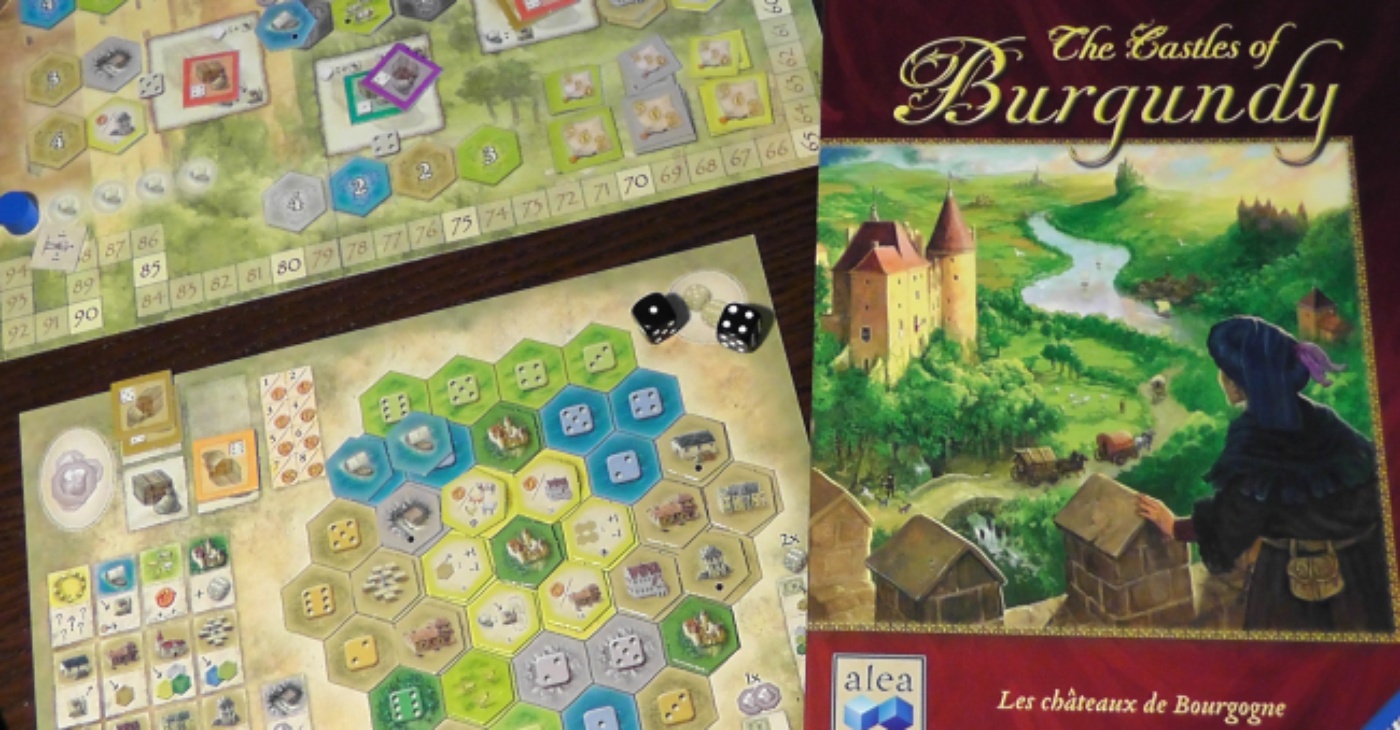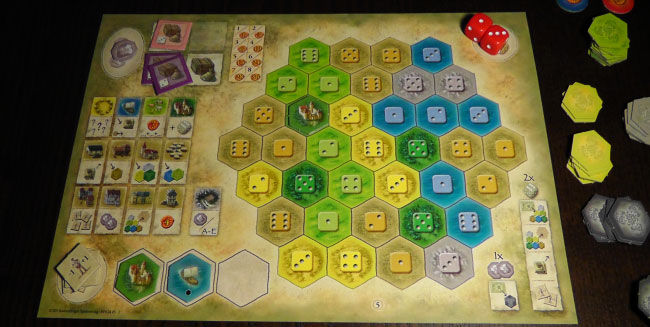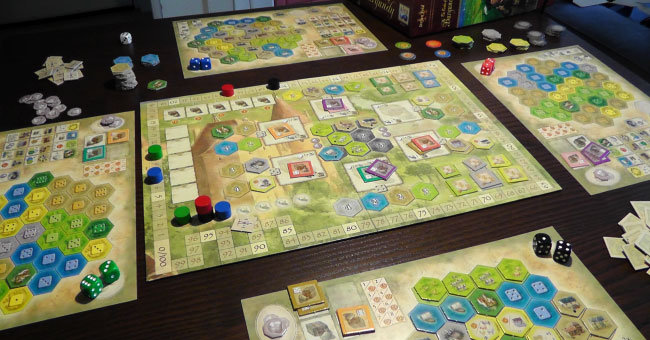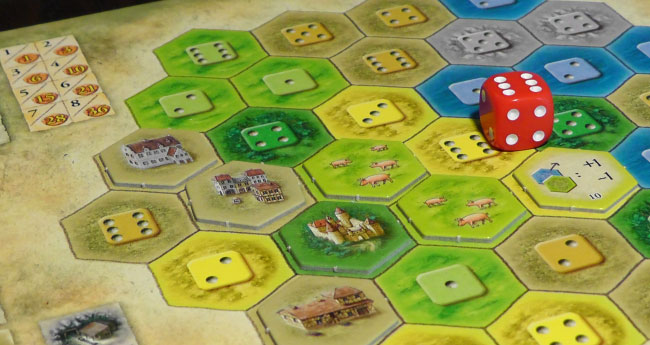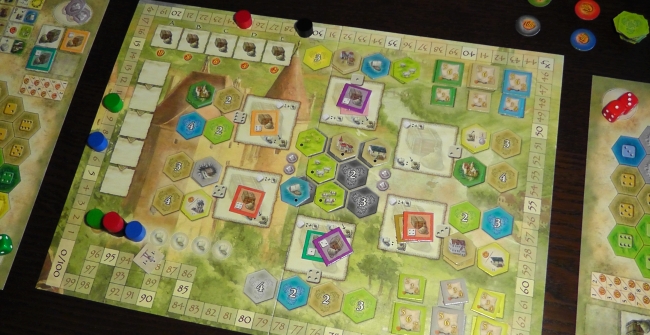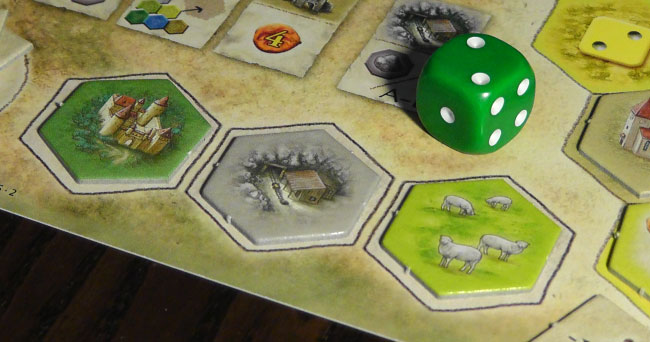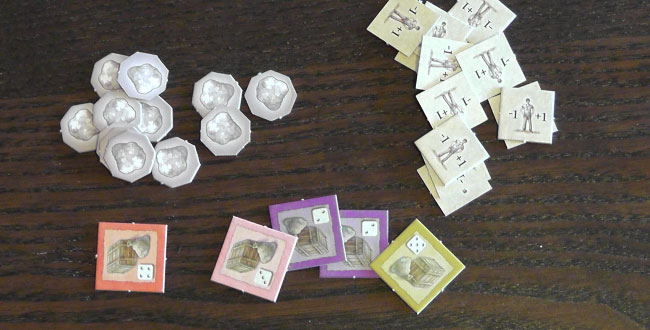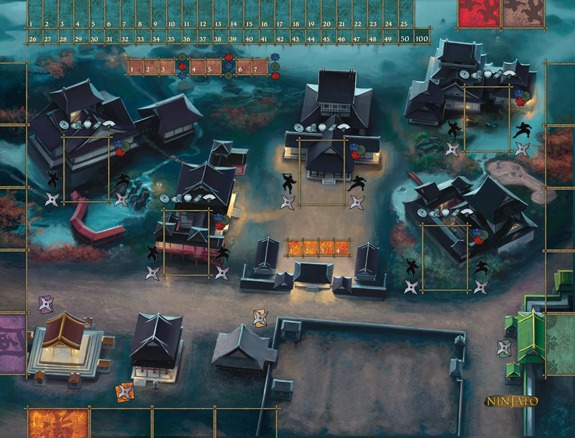Paul: Now, I know what you’re thinking. “Oh, Jesus! That looks like the lovechild of a maths textbook and hotel room art. I’m not having that in my house.”
Hold on. The Castles of Burgundy, which casts 2-4 players as the holders of estates in medieval France, has the whole board game community bleating with quiet joy. We absolutely had to get hold of a copy and try it out. You know what? I actually think it’s quite special, too, although I appreciate it’s such a placid, thoughtful, deeply European game that it won’t be Quinns’s kind of thing. Still-
Quinns: No, no, I really like it.
Paul: You do?
Quinns: Yeah, it’s excellent.
Paul: But-
Quinns: And here’s why!
We’ve never actually covered what a “Eurogame” is on SU&SD, so let’s fix that now.
A Eurogame is a board game that follows the German school of design. As opposed to Ameritrash, which is the genre of glossy components, rich themes and careless conflict, Eurogames espouse simple components, a thin theme, and little direct conflict between players. There’s none of that flash or crunch. Instead, Eurogames are a collection of cleverly integrated mechanics, ticking away on the table like cogs in a pocketwatch.
And to extend that metaphor, the triumph within Eurogames is that they keep perfect time. These are games. Games you can get good at. While Ameritrash might encourage surface conflict, it’s the pro Eurogamer who’ll actually deliver defeats that’ll crush your ego and plans like so much garbage in a trash compactor.
And to extend that metaphor further still, The Castles of Burgundy is no pocketwatch. The staggered and interlinked challenges it offers make it more like a grandfather clock.
Enough wittering! This being a Eurogame, we’re going to have to work doubly hard to showcase the appeal. Let’s start with a look at your private board.
Paul: Say hello to your own, unique estate.
No, I mean it. Say it. Out loud. “Hello, unique estate!”
As you begin the game it’s empty, save for your starting castle. It’s got room for things like villages and mines and pastures, as well as spaces for you to stack your silver and trade goods, even a place for your all important pair of dice, dice we recommend cupping gently, with tenderness, like an ape fondling its balls. You see, you’ll need those dice on your side.
Each hex is a different colour, meaning a different type of tile slots in there, and depending on your player board you have you might have just one colossal town, or scattered forests, a mountain, a mysterious Freemason-like ring of “technology” hexes or anything in between.
To become the best Castler of Burgundy, you want to fill up as much of your board as possible, scoring points every time you complete a region of one colour. The bigger the region is, the more points you score. The sooner in the game you complete it, the more points you score. Complete all of your regions of the same colour before any other player and you’ll score even more points. Easy. As easy as rolling a die.
Oh, the dice. We’ll get to them.
Quinns: So how do you recover these hexes for your own use? Ah! So eager. That’s where the central board comes in.
Five times during the game a seductive assortment of fresh hexes is dumped onto six areas on the central board, corresponding to six sides on a die. What you want to do is heft as much of this stuff as you can away from this central board and hoard it greedily on your own player board. But so does everyone else.
So… your dice.
Paul: The dice!
Quinns: On your turn you’ll roll both dice. Each die is an action. Let’s say you get a 5 on one of them. That 5 can be used to snatch a hex off the “5” area on the central board and slip it into your private board’s pitiful 3-hex storage, OR it can be used to place a hex from your storage onto a “5” slot on your estate.
Okay. I’ve now used the term “hex” and “die” enough that they’re both meaningless to me.
Paul: Hold it together.
The point is, it’s up to you whether you use the numbers to grab, to build or to do both. Which you might think sounds a bit simple. If so, your experience of actually playing Castles of Burgundy would be a bit like falling down an open manhole cover.
Even if your build queue isn’t packed with unplaced buildings and cows and boats, your plans are constantly re-shaped by the numbers you’ve rolled. Most importantly, though, as you start collecting these things and scattering them about your estate like a spasmodic landscape gardener, you unlock all their particular abilities.
Towns spur further construction. Tech tiles permanently enhance your game. Animals simply burp out victory points, but also cause all other animals of the same species, in the same pasture, to burp out yet more points. Boats let you scoop up trade goods off the central board, trade goods we’re not even going to cover in the review because we’re running the risk of writing out the sodding manual.
And there’s a further complications, because it’s at the end of your turns, not the start, that you roll your two dice and determine your options for the next turn. Which is great, sort of. During other players’ turns you’re free to puzzle over your next move. But because you leave these sat in front of you like great big adverts for your intentions, all the other players can then try and scoop up whatever it is they want, or they think you want, just because they feel like screwing you over.
Quinns: So, that’s your problem. Your reward is the dynamite satisfaction you get from a good turn.
Let’s say you roll a 3 and a 4. Woosh, you use the 3 to snatch the castle hex from the central board, summoning jealous mumbles from the table. Everybody wanted that castle.
Quick as a flash, you use the remaining 4 to place the castle on a “4” forest on your board. Pop! For completing the forest you get 7 points, nudging your score marker around the central board, but as a reward for placing a castle you get an extra action. A wild die, essentially. Ka-zap, you use it to place those problem pigs you’ve had in storage since forever, completing a huge pasture for 28 points, plus 4 points for the pigs, plus 12 points for all the other pigs in the pasture! BOOM! A total of 44 points sends your score marker bolting into the lead. That’s bacon power, bitches.
Paul: …
Quinns: …
Paul: …
Quinns: …look, I—
Paul: So anyway, that’s what a great deal of the game is, planning out your estate only for it to grow in unexpected and wonderful (or miserable) ways, and, if you get the opportunity, chaining your actions together so that you can take a thing that lets you do a thing that lets you place a thing that lets you take a thing.
Quinns: Very specific, there.
Paul: Sh. And the rest of the game is throwing your hands up in desperation as someone grabs that building or kidnaps that collection of piglets you so wanted, testing your ability to compromise or re-think with efficiency. Because, this being a Eurogame, the game doesn’t control you via the dice as if it had a cardboard hand on your testes-
Quinns: Or ovaries!
Paul: Or ovaries, no. It gives you options to rethink your strategy.
Here’s where I mention the men and the money. Money (specifically, great chunks of silver) lets you buy extra things from the market in the middle of the board, while workers let you modify your dice rolls. Of course, you can incorporate these cogs into the machinery of your turn, so you use a worker to modify a die roll to buy a building and place a building that gives you money that you can use to buy something from the market, your fellow players left open-mouthed by your cunning. Very nice.
But these are maddeningly scarce resources. More of an ejector seat than anything else. You roll dice and then try to roll with the dice, until finally you can’t take it any more and reach into your wallet. Your wallet of men.
Quinns: Don’t forget the goods (which we’re not describing, APPARENTLY).
Paul: Oh, go on, then.
Quinns: Well! Trade goods appear on the central board each round, and by building ships you can claim little stacks of them, then later sell them for silver and victory points.
See? Simple.
Paul: Hmm. All the same, I feel like we’re making this sound too complex.
It’s not at all. Despite the hideous board, you very quickly grasp all the processes and procedures that tick away inside this game and you can quickly start grabbing hexes and putting them on hexes and covering your land in chickens and chapels. Everything in the game is easy to grasp, and the only trouble you’ll have is remembering what some of the technology or building hexes do, so sometimes you’ll need to refer to the guide in the manual. But that’s the only frustration the rules present.
I really thought you wouldn’t like it, though. You always say you play board games for interaction and excitement and drama. As if you were some kind of horrible first-year acting student, keen to grope and squeal your nights away.
Quinns: Yeah. I’ve been thinking about that.
Paul: About-
Quinns: No, the games bit.
Really, what gives Burgundy its appeal is what gives German boardgaming heavyweight Agricola it’s appeal. You start with a blank canvas and get to build something. You watch it grow, and frustrate and reward you.
The meticulous mechanics themselves are what make Burgundy a fat, canny puzzle that you want to master, but it’s the fact that you’re developing a region that gives the game “glue”, if you will. That capacity to hold your attention.
In conclusion, then: Would you recommend this or Agricola?
Paul: Wellllll, I’d be much more likely to recommend Burgundy to new players because it’s so accessible.
Quinns: Accessible? If I was new to the hobby, went to someone’s house and they put this in front of me I’d deliberately spill wine on it.
Paul: But if you persevered instead of being a grubby vandal, you’d get it. You’d enjoy it.
Quinns: Maybe. It is a lovely game. Just a bit… there’s so much… I think I’d emerge at the end of the evening having been so endlessly teased and tested by the game that I’d have no idea if I had fun or not. I’d definitely place it at the more hardcore end of the spectrum.
Paul: Well, nevermind that then. We are, at least, agreed that it’s a fantastic game?
Quinns: A fantastic Eurogame, definitely. If you’re looking for a quiet, cerebral title where you can marvel at the design rather than just a bunch of buffed components and flashy ideas, Castles of Burgundy is here to serve.

